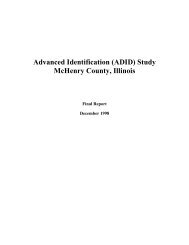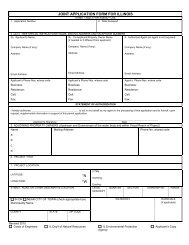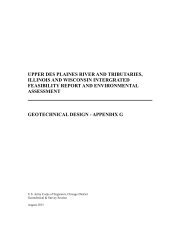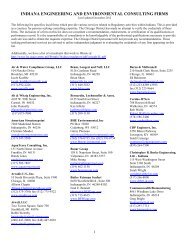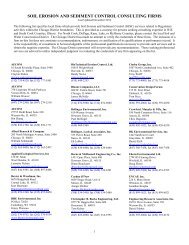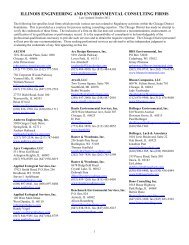Civil Works Policy Guidebook.indd - Chicago District - U.S. Army
Civil Works Policy Guidebook.indd - Chicago District - U.S. Army
Civil Works Policy Guidebook.indd - Chicago District - U.S. Army
Create successful ePaper yourself
Turn your PDF publications into a flip-book with our unique Google optimized e-Paper software.
CAP Section 205 Small Flood Risk Management Projects<br />
Section 205 of the Flood Control Act of 1948, as amended<br />
What the U.S. <strong>Army</strong> Corps of Engineers Can Do<br />
The U.S. <strong>Army</strong> Corps of Engineers is authorized to construct local flood protection projects or improvement of flood control<br />
works. The types of studies and/or projects are tailored to be site specific. Typical flood risk management projects may include<br />
levees, floodwalls, impoundments, pumping stations, and channel modifications as well as non-structural measures.<br />
Non-structural measures reduce flood damages by changing the use of floodplains or by accommodating existing uses to<br />
the flood hazard. Examples include flood proofing, relocation of structures, and flood warning and preparedness systems.<br />
The U.S. <strong>Army</strong> Corps of Engineers oversees planning, design, and construction of flood risk management projects in<br />
close coordination with the project sponsor.<br />
Study Process<br />
Before the federal government can participate in implementing a flood risk management project, a planning study must<br />
be conducted to determine if the project is economically justified (benefits exceed the costs), technically feasible, and<br />
environmentally acceptable. Planning studies are typically conducted in two phases - reconnaissance and feasibility. Each<br />
project is limited to a total federal cost of $7 million.<br />
Project Phase and Funding<br />
The feasibility study is 100 percent federally funded up to $100,000, any cost to the study after $100,000 will be shared at<br />
50 percent federal and 50 percent non-federal requiring a Feasibility Cost Sharing Agreement (FCSA) with the sponsor(s).<br />
Design and implementation is cost shared 65 percent federal and 35 percent non-federal. The sponsor must contribute 35<br />
percent (minimum 5 percent cash) of the total project implementation cost as cash or lands, easements, rights-of-way, relocations,<br />
and disposal areas (LERRDs). If the value of the LERRDs plus the cash contribution does not equal or exceed<br />
35 percent of the project cost, the sponsor must pay the additional amount necessary so that the sponsor’s total contribution<br />
equals 35 percent of the project cost.<br />
Responsibility of Project sponsor<br />
Formal assurance in the form of a project partnership Agreement must be executed with the project sponsor. The U.S.<br />
<strong>Army</strong> Corps of Engineers would oversee project construction; however, once constructed, the maintenance and operation<br />
of the project would be the responsibility of the project sponsor.<br />
How to Request Assistance<br />
An investigation of a prospective small project under Section 205 may be initiated upon receipt of a request from a sponsoring<br />
agency empowered under state law to provide local partnership and availability of funds..<br />
Project requests should be directed to:<br />
Susanne J. Davis, P.E.<br />
Chief Planning Branch<br />
U.S. <strong>Army</strong> Corps of Engineers<br />
Office: (312) 846-5580<br />
susanne.j.davis@usace.army.mil<br />
R<br />
14



